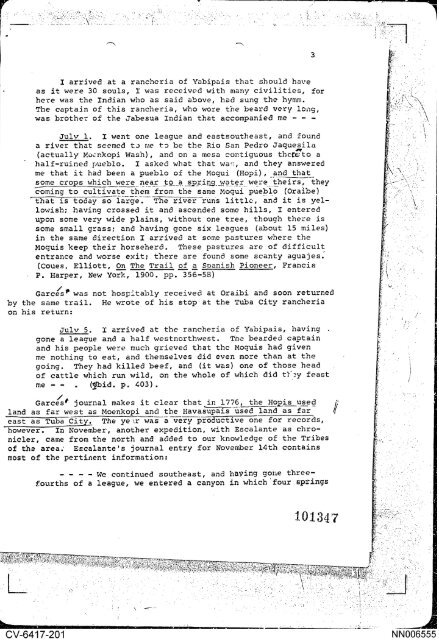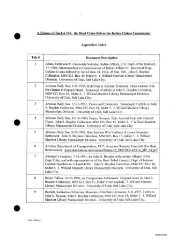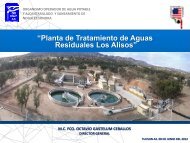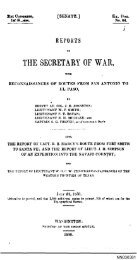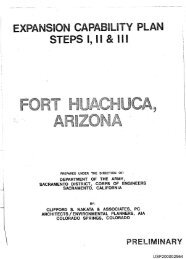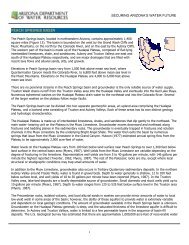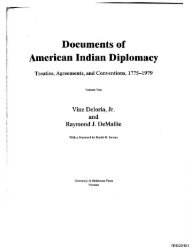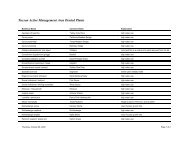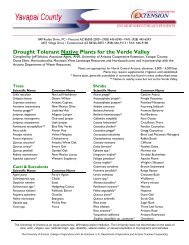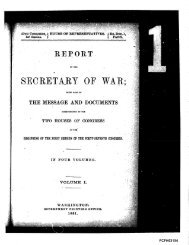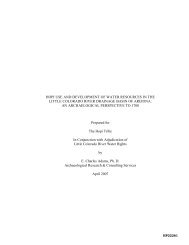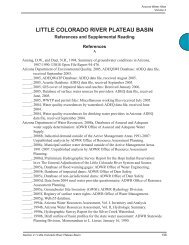By David Brugge - Arizona Department of Water Resources
By David Brugge - Arizona Department of Water Resources
By David Brugge - Arizona Department of Water Resources
You also want an ePaper? Increase the reach of your titles
YUMPU automatically turns print PDFs into web optimized ePapers that Google loves.
I arrived at a ranchcria <strong>of</strong> Yabipais that should have<br />
as it were 30 souls, 1: was received with many civilities, for<br />
here was the Indian who as said above, had sung the hymm.<br />
The captain <strong>of</strong> this rancheria, who wore the beard very long,<br />
was brother <strong>of</strong> the Jabesua Indian that accompanied me - - -<br />
Julv 1. I went one league and eastsoutheast, and found<br />
a river that seemed t~ ne t3 be the Rio San Pedro Jaquesila<br />
fl<br />
(actually Nucnkopi wash), and on a mesa zon.tiguous thereto a<br />
half-ruined pueblo. I asked what that Wac:, and they answered<br />
me that it had been a pueblo <strong>of</strong> the Ploqui (~opi), ......- and ----- that<br />
some crops which were . near _ to a -. -- s_p_ring-~~t~gr-~~wc_re-~&heirs, they<br />
koming to cultivate -- - -. them .- .- - from the same Moqui pueblo (~raibe)<br />
- -- .<br />
..<br />
that is today so large. The river runs little, and it is yellowish;<br />
having crossed it and ascended some hills, I entered<br />
upon some very wide plains, without one tree, though theze is<br />
some small grHss: and having gone six leagues (about 15 miles)<br />
in the same direction I arrived at some pastures where the<br />
Moquis keep - their horseherd. These pastures are <strong>of</strong> difficult<br />
entrance and worse exit; there are found ,some scanty aguajes.'<br />
(Coues, Elliott, The Trail <strong>of</strong> a Spanish Pioneer, Francis<br />
P. Harper, New York, 1900. pp.T56-58)<br />
~arce/s+ was not hos~itably received at Oraibi and soon returned<br />
by the same trail. He wrote <strong>of</strong> his stop at the Tuba City rancheria<br />
on his return:<br />
-' Julv 5 T arrived at the rancheria <strong>of</strong> Yabipais, having .<br />
gone a league and a half westnorthwest. The bearded captain<br />
and his people were much grieved that the Moquis ha6 given<br />
me nothing to eat, and themselves did even more than at the<br />
going. They had killed beef, and (it was) one <strong>of</strong> those head<br />
<strong>of</strong> cattle which run wild, on the whole <strong>of</strong> which did t 1 - 2 ~ feast<br />
me - - . @bid. p. 403) .<br />
/<br />
~arces~ journal makes it clear that in 1776, the Ho~is - used - -<br />
land as far west as Moenkopi ------ and the Havasupals used land as far<br />
east as Tuba city. The ye.ir was a very productive one for recorbs,<br />
however. In November., another expedition, with Escalante as chronicler,<br />
came from the north and added to our knowledge <strong>of</strong> the Tribes<br />
<strong>of</strong> the area; E~calante's journal entry for November 14th contains<br />
most <strong>of</strong> the pertinent information:<br />
- - - - W e continued southeast, and having golie three-<br />
fourths <strong>of</strong> a league, we entered a canyon in which'four springs


